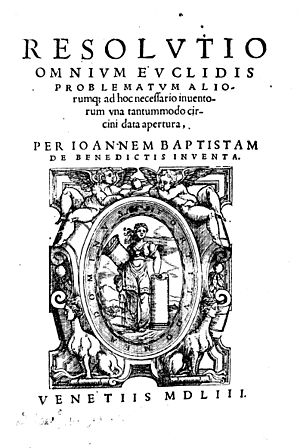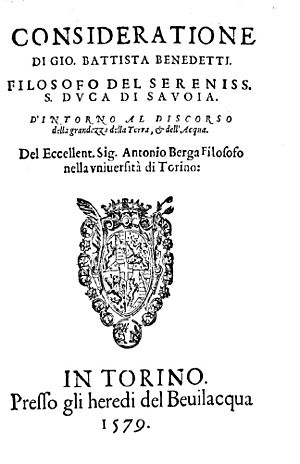Giambattista Benedetti facts for kids
Quick facts for kids
Giambattista Benedetti
|
|
|---|---|
| Born | 14 August 1530 |
| Died | 20 January 1590 (aged 59) |
| Scientific career | |
| Fields | Mathematician |
Giambattista Benedetti (born August 14, 1530, died January 20, 1590) was a smart Italian scientist from Venice. He was a mathematician, but he also studied physics, how things move (mechanics), how to build sundials, and the science behind music.
Contents
How Things Fall: Benedetti's Ideas
In the 1500s, people mostly believed in Aristotle's ideas about how things fall. Aristotle thought that heavier objects fall faster than lighter ones. He also believed that things fall slower in thick air or water.
Benedetti's New Theory
Giambattista Benedetti had a different idea. He wrote about it in his books Resolutio omnium Euclidis problematum (1553) and Demonstratio proportionum motuum localium (1554). Benedetti said that how fast something falls depends on the difference between its own weight (or density) and the density of the air or water it's falling through.
This meant that two objects made of the same material, but with different weights, would fall at the same speed. For example, a big rock and a small rock of the same type would hit the ground at the same time. This was different from Aristotle's idea.
Falling in a Vacuum
Benedetti also thought that if there was no air (a vacuum), objects made of different materials would still fall at different speeds. But they would fall at a steady, fast speed.
Later, Benedetti added to his theory. He said that the shape and size of an object also affect how fast it falls. This is because air resistance pushes against the object. So, two objects of the same material but different sizes would only fall at the same speed in a vacuum.
Galileo and Benedetti
Many scientists believe that Galileo Galilei, another famous Italian scientist, learned a lot from Benedetti's work. Galileo's early ideas about how things fall were very similar to Benedetti's first theory.
The Science of Music
Benedetti was also very interested in music. He wanted to understand why some musical sounds (like two notes played together) sound good (consonant) and others sound bad (dissonant).
Sound Waves and Harmony
Around 1563, Benedetti wrote a letter to a famous musician named Cipriano de Rore. In this letter, Benedetti suggested a new idea. He said that sound travels in waves, like ripples in water.
He believed that when musical notes sound good together, their sound waves meet up regularly. For example, if one note has short, fast waves and another has longer, slower waves, they would still line up often. This regular meeting of waves makes the sound pleasing to our ears.
Measuring Consonance
Benedetti even tried to measure how "good" a musical interval sounded. He used a math idea where he multiplied two numbers that describe the musical interval. This was an early way to try and measure how harmonious sounds are.
Later scientists, like Isaac Beeckman and Marin Mersenne, used Benedetti's ideas in their own studies of music. Even centuries later, scientists like Hermann von Helmholtz and James Tenney built on Benedetti's work to understand how we hear and enjoy music.
Works
See also
 In Spanish: Giambattista Benedetti para niños
In Spanish: Giambattista Benedetti para niños



